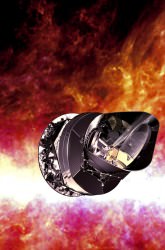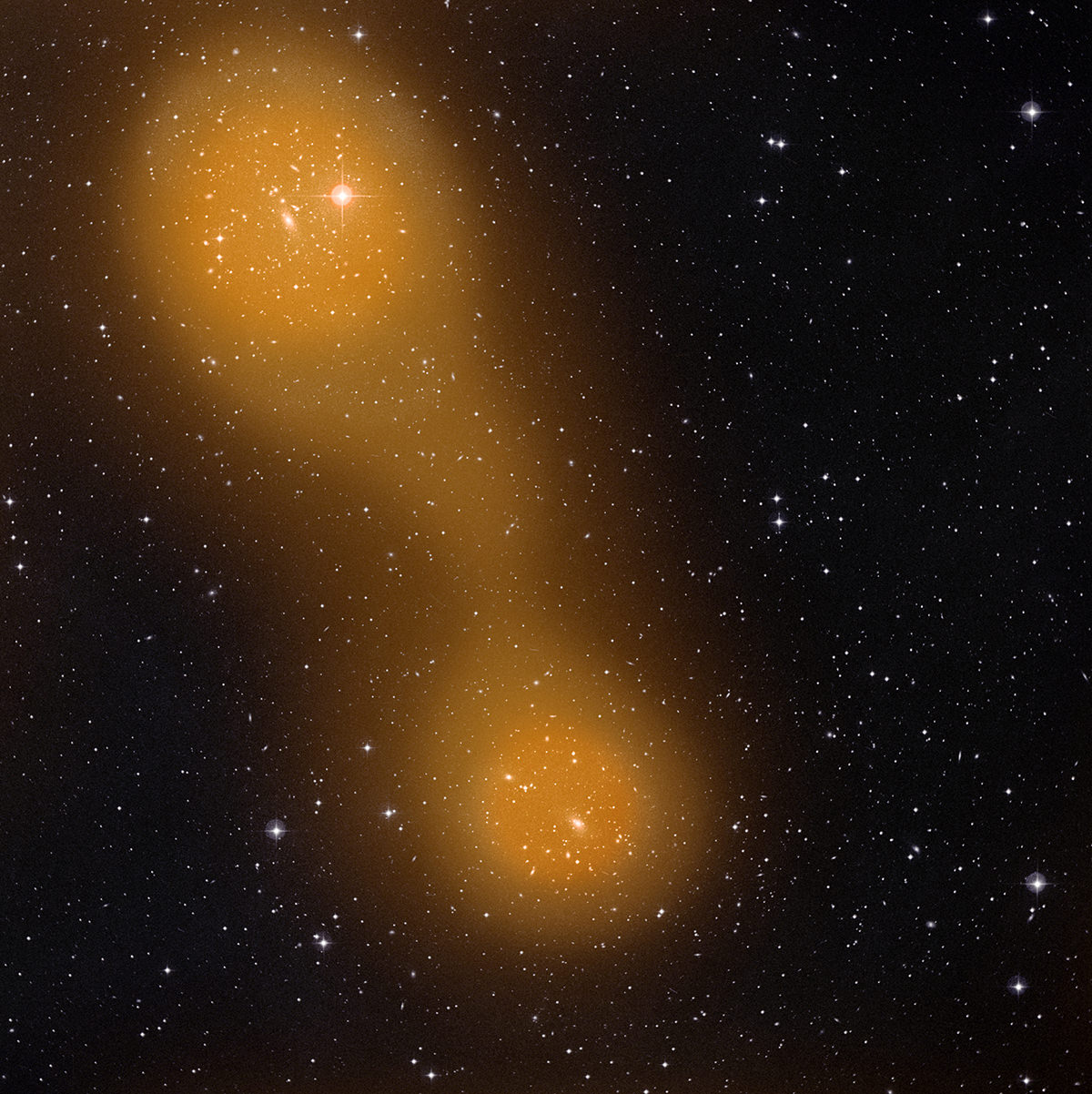An “bridge” of hot gas stretches between galaxy clusters Abell 401 and Abell 399
It may not be good practice to burn bridges but this is one super-heated bridge that astronomers were happy to find: an enormous swath of hot gas connecting two galaxy clusters 10 million light-years apart, and nearly a billion light-years away.
Using ESA’s Planck space telescope, astronomers have identified leftover light from the Big Bang interacting with a filament of hot gas stretching between Abell 401 and Abell 399, two galactic clusters each containing hundreds of individual galaxies.
 Launched in May 2009, Planck is designed to study the Cosmic Microwave Background (CMB) — the leftover light from the Big Bang. When this radiation interacts with large-scale cosmic structures, like the hot gas bridging clusters of galaxies, its energy is modified in a specific way. This is referred to as the Sunyaev–Zel’dovich Effect (SZE), and Planck is specifically attuned to finding it.
Launched in May 2009, Planck is designed to study the Cosmic Microwave Background (CMB) — the leftover light from the Big Bang. When this radiation interacts with large-scale cosmic structures, like the hot gas bridging clusters of galaxies, its energy is modified in a specific way. This is referred to as the Sunyaev–Zel’dovich Effect (SZE), and Planck is specifically attuned to finding it.
This, however, is Planck’s first discovery of inter-cluster gas found using the SZ technique.
The temperature of the gas is estimated to be around 80 million degrees C, similar to the temperature of the gas found within the clusters themselves. It’s thought that the gas may be a combination of cosmic web filaments left over from the early Universe mixed with gas from the clusters.
The image above shows the clusters Abell 401 and Abell 399 as seen at optical wavelengths with ground-based telescopes overlaid with the SZE from Planck. The entire bridge spans a distance about the size of two full Moons in the sky.
Read more on ESA’s news page here.
Top image: Sunyaev–Zel’dovich effect: ESA Planck Collaboration; optical image: STScI Digitized Sky Survey. Inset image: Artist’s impression of Planck against the CMB. (ESA and the HFI Consortium, IRAS)


A preprint of the paper is available here: http://arxiv.org/abs/1208.5911
Thanks for that link, Jon; I’ve been a bit lazy lately!
Thanks for this. A new observation technique – and it’s hot!
Here’s a question that I haven’t found a good answer for yet in my travels…. The hot gas is detected to be 80 million degrees, which is pretty hot, though it must also be very diffuse. If a theoretical spaceship were to fly through this intergalactic space, would it be subjected to such an extreme thermal effect? These temperatures seem contrary to the idea that most space is close to absolute zero.
What we are talking about here is the electron temperature of the hot gas/plasma.
How does the electron temp relate to standard temp? That wiki entry referred to standard temp as being 2/3 of the average energy, but i still don’t fully understand how the two relate… in a way that can easily be explained to non-specialists, of course. Looking up Maxwell-Boltzmann distributions didn’t get me very far. Thanks!
As stated at the second link, electrons can reach thermodynamic equilibrium among themselves much faster than ions and neutral atoms because of the large difference in mass – an electron has 1/1800 of the mass of a proton – and for this reason the “electron temperature” can be many orders of magnitude higher than the ions or neutral atoms.
cool (so to speak), thanks Ivan, now we’re getting closer to the
answer I seek. 🙂 Now 80 million / 1800 = approx 44,000 degrees …
though i imagine this isn’t a linear relationship, because that still
seems pretty hot for intergalactic space! sorry to keep at this, but
this has actually been bugging me for awhile. Many blogs and astronomy
articles reference these massive intergalactic temperatures (for what
I assume is diffuse plasma), but never have I heard a layman’s
explanation of what these numbers mean in any kind of practical sense,
and therefore I find the reporting somewhat misleading to the
non-specialist reader. And yeah, i studied university math & physics
for 2 years, many moons ago, so I have the basics. But I would love to
know how hot it “really is” out there.
The Sunyaev–Zel’dovich effect is an inverse Compton scattering process. The high temperature, and thus high energy, electrons in a plasma interact with the low energy microwave photons from the CMB. These photons gain energy and are thus of shorter wavelength. By knowing the frequency of the incident radiation, in this case the CMB microwave, and measuring the increase in the energy of the SZ boosted photons you can calculate the energy of the intervening plasma.
LC
simple question: Why are the electrons so excited? (Are they waiting for that announcement from Curiosity as well?) What allows them to maintain their state of excitement? Also, I always wonder when interstellar/intergalactic gas is described how diffuse it actually is. To me, in earthly/lay experience, gas can be felt or seen as a fog. I know it’s far more rarefied than that. How much more?
Uh oh. There may be many mechanisms. Hopefully someone knowledgeable gest back to us on that.
Meanwhile here is one description of intracluster gas FWIW, as the temperatures are “similar” et cetera:
“The ICM is heated to high temperatures by the gravitational energy released by the formation of the cluster from smaller structures. Kinetic energy gained from the gravitational field is converted to thermal energy by shocks.”
Please note that the article isn’t well referenced though!
As for the density in the filament, I would assume we would have to wait for the paper. Again, the link gives a coarse description:
“Although the ICM on the whole contains the bulk of a cluster’s baryons, it is not very dense, with typical values of 10^?3 particles per cubic centimeter. The mean free path of the particles is roughly 10^16 m, or about one lightyear.”
Meaning that if you count nuclei, they look like a handful. But if you “ask” them how densely packed they are, they will tell you they seldom meet.
Thanks, Torb. I don’t quite “get” gravitational energy unless it means, “falling”. Or does the cluster convert the falling energy of it’s constituents to heat and then re-emit that via star formation and output to the distant gases? Also, since I suck at math, does your description give us one particle of ICM gas in 1000 cubic centimeters (one cubic foot)?
theses answers are fairly strait forward. Newtons Law keeps the electrons in an excited state. “an object in motion tends to stay in motion until acted upon by an external force” in the vacuum of space there is little to no interference upon the particles themselves. they therefore remain in their excited state because there is no medium to transfer the energy. While on earth many gasses can be percieved as a fog and sometimes be felt, this is relative to the density of the gas, for example; when its foggy outside you can walk out into it. your eye percieves the most immideate density so our eyes can essentially peirce through for a few feet. hence the fog always appears denser from a distance. The density of this phenonmena is percieved from many lightyears away, so while to us it appears as a dense cloud, if one were to be emmersed into it directly, it could seem to not even be there.
I think the answer you are looking for is that the bulk of a spaceship would be pretty cool at non-relativistic speeds, or in other words livable. (I.e. not heated up by collisions at high relative velocities).
The craft can radiate heat faster than the dilute plasma can transfer heat, and it can radiate a heat excess because the gas is not at equilibrium with respect to the CMB. As witnessed by the SZ effect by the way, see lcrowell’s comment.
Another cool hot system are metals. The same effect have the valence electrons, the freely movable ones, hotter. (Roughly, since there are effects changing electron effective mass in bound systems.) A ~ 300 K room temperature metal has ~ 20 000 K electrons, IIRC.
Great, thanks for all the info. This makes sense, though I find it odd that I’ve never seen this clarified before… the casual reader may think that intergalactic space is hotter than the center of the Sun! Anyway, this will clearly save me lots of money on thermal-shielding when I build my ship. 😉
It has a lot to do with density too, as I recall. While the gas is hot, it is extremely diffuse and any particular area of space within it — say, that taken up by a theoretical spaceship — would likely encounter only a few molecules of it. Without anything to transmit this heat — which isn’t in the infrared, either — it really wouldn’t be “felt”.
this is a major find.